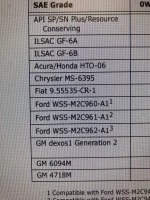So let me get this straight. In order to try to meet the stringent EPA CAFE standards, Auto companies use Direct Injection which gets more mileage. But the consequence of that is more Soot in the environment. Soot that gas engines did not produce before. So what have they accomplished??
I think a lot of this LSPI is caused by transmission software that tries to to shift into the highest gear as early as possible. I have noticed this with a couple of rental cars. Let up on the gas and it shifts into the highest gear. Then you need to accelerate and there is nothing while it figures out what gear to shift to. So it's laid in the oil companies lap to try to fix it??
I think a lot of this LSPI is caused by transmission software that tries to to shift into the highest gear as early as possible. I have noticed this with a couple of rental cars. Let up on the gas and it shifts into the highest gear. Then you need to accelerate and there is nothing while it figures out what gear to shift to. So it's laid in the oil companies lap to try to fix it??


